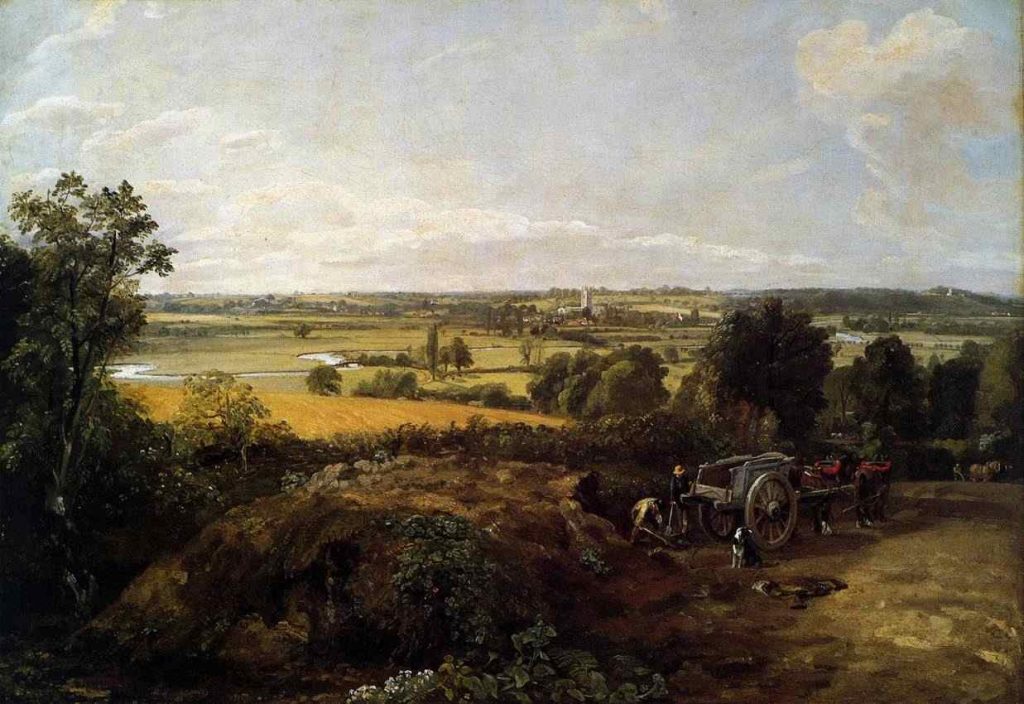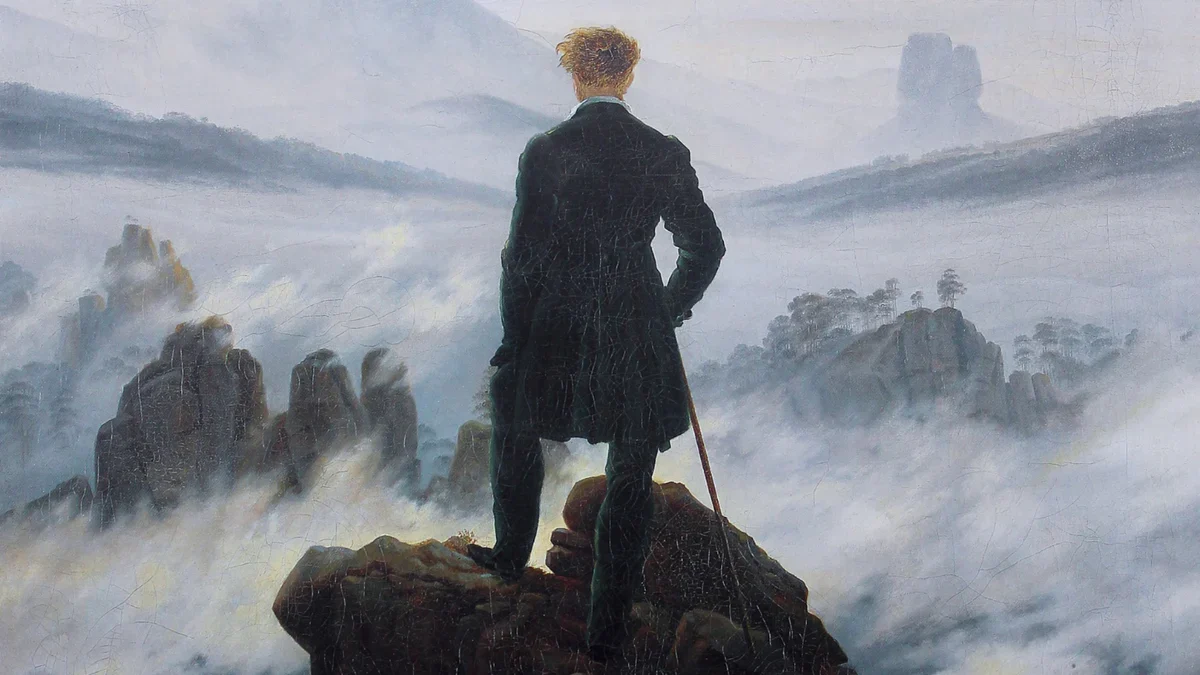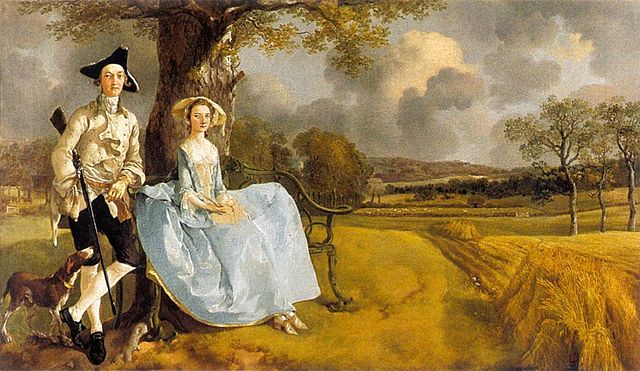What is Romanticism? A Journey Through Romanticism in English Literature
By Tamara Trpkovska
The Romantic period in English Literature is by far the shortest, but it is as complex and diverse as any other period of British literary history. This movement appeared in the late 18th century, around the time of Samuel Johnson’s death and works by Blake, Burns, and Smith were published, and finished around the middle of the 19th century when most of the major writers of the preceding century were either dead or no longer active.
This period was a very turbulent one, during which England underwent many changes. It shifted from an agricultural society, where wealth and power were dominant, to a modern industrial nation influenced by the revolutionary ideas that arose in America and France.

Who Were the Romantics?
Writers during this period did not call themselves “Romantics”; the name was given by English historians half a century later. At first, they were treated as independent individuals, or they were grouped into three separate schools:
- Lake School: Wordsworth, Coleridge, and Robert Southey.
- Cockney School: Leigh Hunt, William Hazlitt, and Keats.
- Satanic School: Percy Shelley, Byron, and their followers.
Many writers felt the uniqueness of their period. They felt the pervasive intellectual and imaginative climate, often called “the spirit of the age”. This phrase refers to the general mood, ideas, beliefs, and feelings that define a particular historical period. In the Romantic period, this describes the shared sense among writers that they lived in a time of major changes – emotionally intense, imaginative, rebellious, and questioning old rules and traditions. It captures an era where individualism, emotion, and nature dominate, as well as the feeling of being part of something significant and transformative compared to the past.
In the sections that follow, we’ll explore how Romantic writers reshaped poetry, art, and thought — leaving a legacy that still shapes culture today. They had a big role in the evolution of english language.
Themes and Characteristics of English Literature
The term Romanticism does not necessarily stem from the concept of love, but it comes from the French word romaunt, which means a romantic story told in verse. The main focus of this period was on emotions and the inner life of the poet. Poets valued intuition and subjective expression over reason and logic, and they often used personal experiences and inner emotions for their work. They explored themes like nature, the sublime, and the individual’s connection to the world, which made their works more intense, passionate, and introspective
Characteristics of the Romantic Period
The Romantic period is known for six characteristics:
- Celebration of nature
- Focus on the individual and spirituality
- Celebration of isolation and melancholy
- Interest in the common man
- Idealization of women
- Personification and pathetic fallacy.
These themes helped shape the literature of the time, making it more passionate, emotional, and focused on the human experience. In the following sections, we will explore each characteristic in greater detail, analyzing how they manifest in the works of Romantic poets and their lasting impact on literature and culture.
Celebration of nature
The celebration of nature is the central theme in the Romantic movement. It emphasizes the beauty, power, and spiritual importance of the natural world. Nature is not only portrayed as a source of inspiration and emotional connection but also as a refuge from the limitations of industrialization and urban life.
Through vivid imagery and personal reflection, Romantic writers highlight the deep connection between humans and nature and celebrate its raw, natural beauty.
Poets like Wordsworth and Coleridge often used nature as a main theme in their works, aiming to present nature’s healing power for the human spirit.
Wordsworth often implemented vivid imagery to evoke sensory experiences that would immerse the readers in the beauty and grandeur of nature. With his rich and detailed description of landscapes such as vibrant flowers, flowing rivers, and majestic mountains, he succeeded in drawing the readers directly into the scenery. Wordsworth used personification and emotive language, which helped readers to feel an emotional connection to the natural elements described in his work, strengthening the idea that nature is not just a background idea but a vital source of inspiration.
If you are interested in exploring how this theme is brought to life in a real literary work, these are some great examples you should check out!
- “I Wandered Lonely as a Cloud” by William Wordsworth
This poem grasps the beauty and tranquility of nature through the poet’s personal experience of finding solace and inspiration in a field of daffodils. Through this poem, Wordsworth emphasizes nature’s power to uplift and rejuvenate the human spirit.
- “Ode to the West Wind” by Percy Bysshe Shelley
Shelley’s Ode to the West Wind exemplifies nature’s power and its connection to the individual. Through passionate language, the poem shows how nature can fuel both creativity and transformation.
- “To Autumn” by John Keats
Through rich imagery, Keats celebrated the beauty of the autumn season and its symbolic link to the cycle of life. He captures the serenity and the peacefulness, the reflective quality of nature, and presents how nature can be both an inspiration and solace.Focus on the individual and spirituality
During Romanticism, poets started to value personal experiences, emotions, and expressions of the self as a path to deeper truths, rejecting the uniformity of the Enlightenment. Romantics placed the individual at the center of their work. They celebrated personal freedom, self-expression, and the exploration of human emotions.
During this period, many writers turned to spirituality, seeking answers from within rather than relying upon external authorities. For example, William Blake combined mystical vision with poetic expression, emphasizing spiritual insight that came from within.
The idea of individuality is perfectly embraced by Lord George Byron in his creation of the Byronic Hero, who is the archetype of all the dark and brooding antiheroes of fiction. Byron’s Manfred is one of the earliest representations of this character, which displays many features like: a sinister power, a sophisticated world view, intense forbidden erotic love, and fierce independence. Inspired by various parts of Milton’s Satan, and the emerging idea of the “Satanic hero”, with influence of Napoleon and Gothic Novels, the “Byronic hero” carries rebellion and tragedy in its heart. However, the true “Byronic hero” is presented as being more isolated, dark, complex in his history and inner conflict, therefore more compelling and frightening to its readers.
If you want to dive more into the themes of spirituality and individualism, you should read the following works:
- “The Tyger” by William Blake: This poem is a powerful reflection on creation, divine mystery, and inner vision.
- “Lines Written a Few Miles above Tintern Abbey” by William Wordsworth: A personal poem about memory, nature, and the poet’s spiritual growth.
- “Manfred” by Lord Byron: A poem that showcases the complexity and torment of the Byronic hero and his spiritual questioning.
Celebration of isolation and melancholy
In the 18th century, the concept of sensibility – being emotional and sensitive was equivalent to politeness and good manners. However, people started noticing that too much sensibility causes various kinds of mental struggles. Romantic writers and artists focused on inner emotion and the painful part of life, thinking too deeply about how pain and suffering could cause sadness and even depression.

The melancholic person was seen as brooding and restless, haunted by fears, pessimistic about the possibility of improvement, and lacked meaning or purpose. The feeling of deep sadness and longing for something could not be explained, therefore, these emotions were sources of inspiration and creativity.
Melancholy became one of the central themes in the Romantic period. The idea of “The Sublime” in landscapes was associated with dangerous places. The Romantic love was strictly about pain, heartbreak, loss, and rejection. People could feel sadness and anger as easily as they could feel joy.
Romantics saw themselves as dreamers and idealists; however, that made them lonely and misunderstood. For some, death was the only escape from a life filled with constant loss and sadness.
The Romantic melancholy came about from the difference between the real world and the perfect, dream-like one the Romantics had hoped for. They felt the feeling of joy when their dreams seemed close, but deep sadness once they realized their dreams would not last.
The Romantics were aliens to the world due to their strong political beliefs and difficult personalities. Since they could not and did not want to fit in, they expressed their frustration through feelings of melancholy and sadness.
Here are some suggestions of Romantic works that beautifully explore the theme of isolation and melancholy;
- “Ode on Melancholy” by John Keats: Keats urges readers not to avoid their melancholy. He shows how joy and sadness are interconnected. This poem is filled with imagery and philosophical reflection, making it the best Romantic meditation on emotion.
- “Dejection: An Ode” by Samuel Taylor Coleridge: This poem is a deep and personal expression of despair and emotional numbness. Coleridge explores how nature, once a source of joy and inspiration, can lose its meaning when the person struggles with sadness and depression. This haunting work perfectly reveals the Romantic struggle between inner turmoil and outward beauty.
- “When I Have Fears That I May Cease to Be” by John Keats: Keats, in this sonnet, expresses anxiety over dying young and failing to achieve his creative and romantic potential. The sonnet captures both ambition and the existential dread – loneliness, longing, and the fleeting nature of life – all major concerns during this period.

Interest in the common man
Poets in the Romantic period turned their attention to the common man, uplifting the voices of the people often neglected by society. In their works, they celebrated the rural life and delved into the struggles and triumphs of ordinary people, making them worthy subjects of literature.
William Wordsworth was one of the first poets to embrace the idea of writing a piece that could be understood, analyzed, read, and enjoyed by anyone. He rejected using overly stylized language. Wordsworth would use classical works in favor of emotional imagery, which was written in simple and elegant language.
Romantics believed that knowledge is best gained through intuition rather than deduction. This is perfectly explained by Wordsworth, who stated that “all good poetry is the spontaneous overflow of powerful feeling.”
To explore how Romantic poets gave voice to ordinary lives, take a closer look at the following works:
- “Michael” by William Wordsworth: A story about a shepherd and his son that highlights rural life, family bonds, and emotional depth while empowering the dignity of an ordinary working man through poetic storytelling.
- “The Chimney Sweeper” by William Blake: Blake gives a voice to a young child laborer, revealing the hard reality faced by the poor. That poem critiques the religious hypocrisy while emphasizing and showing compassion to the voiceless.
- “The Solitary Reaper” by William Wordsworth: In this poem, Wordsworth talks about a humble Highland girl whose singing moved the poet. He perfectly illustrated how beauty and depth can be found in the everyday lives of ordinary people.
Idealization of women
In the Romantic era, women were seen as innocent, pure creatures who should be admired and respected. Therefore, many Romantic poets and novelists centered their narratives around celebrating the purity and beauty of women.
Sadly, the idealization of women meant that women during this period were seen as objects for male admiration rather than people with their own dreams and ambitions. Ironically, the most famous novels from this period were written by women (Jane Austen, Charlotte Brontë, and Mary Shelley). However, these writers had to publish their work under male pseudonyms.
In conclusion, most of the romantic literature is filled with the concept of women being perfect and innocent beings who were meant to be loved, respected, and mourned, but never touched or relied upon.
Look at the suggested works that perfectly represent the idealization of women:
- “She Walks in Beauty” – by Lord Byron: The poet describes a woman’s beauty in spiritual and almost divine terms, focusing on her purity, grace, and the harmony between her inner and outer self.
- “La Belle Dame sans Merci” by John Keats: Keats portrays a mysterious and beautiful woman who lures a knight into emotional ruin. This haunting work shows how women are usually presented as enchanting but dangerous figures – idealized yet unreachable.
- “The Eve of St. Agnes” by John Keats: With a blend of passion and innocence, a young woman is portrayed in a dreamlike, fairy-tale world. She I portrayed as pure, ethereal, emphasizing the Romantic tendency to elevate women beyond reality.
Personification and pathetic fallacy
Pathetic fallacy is the attribution of human feelings and thoughts to aspects of nature. Writers use the pathetic fallacy to evoke a specific mood or feeling that usually reflects their own or a character’s internal state.
The word “pathetic” in this context relates to the word “pathos”, which means emotion. Furthermore, the word “fallacy” means falseness rather than flawed reasoning.
A perfect example of Pathetic Fallacy is “I Wandered Lonely as a Cloud”, where Wordsworth gave the title itself human characteristics to a cloud. Another great example is the personification and pathetic fallacy used in Mary Shelley’s Frankenstein:
Its fair lakes reflect a blue and gentle sky; and, when troubled by the winds, their tumult is but as the play of a lively infant, when compared to the roarings of the giant ocean.
If you want to check out more works such as the ones mentioned before, check the suggestions below:
- “Frankenstein” by Mary Shelley: Using the weather and nature to reflect the characters’ emotional state, Mary successfully implements the main themes and characteristics of the Romantic Era. Storms, fog, and darkness often mirror Frankenstein’s inner turmoil and the creature’s loneliness.
- “The Prelude” by William Wordsworth: Wordsworth often personifies nature by giving mountains, rivers, and winds emotional qualities. In this work, nature responds to and reflects his inner spiritual journey.
- “To a Skylark” by Percy Bysshe Shelley: Shelley, in his poem, praises a bird for its joyous song, giving it human-like emotions and elevating it as a symbol of ideal artistic inspiration, full of light and freedom beyond human sorrow.
English Language through Romantic Books
Learning new languages is always fun; however, learning through books not only improves your English but also improves your creativity, creative thinking, and imagination.
During the Romantic Era, some of the best classics were published. Here are a few Romantic Period books that are both enjoyable to read and easy to understand. They might for sure improve your english skills
- Jane Austen – Pride and Prejudice: Jane Austen is one of the most famous authors of the Romantic Period. Her works are often used as educational material when the Romantic era is introduced to the students. Pride and Prejudice is a witty. Elegant novel filled with sharp dialogue and social commentary, which is great for familiarizing oneself with formal English and understanding sentence structure.
- Mary Shelley – Frankenstein: This novel falls into the Gothic Literature. Frankenstein is a compelling novel, rich in emotional language, vivid description, and philosophical depth. This work is a great choice for expanding your vocabulary while exploring themes of identity, ambition, and humanity.
- William Wordsworth – The Prelude: This autobiographical poem explores personal growth, nature, and reflection. The Prelude is a great choice for advanced learners who are looking to explore poetic language and expand their understanding of figurative expressions.
Want to improve your speaking and conversation skills? Join our WhatsApp course—perfect for practicing English and getting feedback from experienced tutors.
Frequently Asked Questions (FAQ)
Why is Romantic literature useful for learning English?
Romantic literature exposes readers to rich, expressive language. It helps build vocabulary, understand emotional tone, and recognize literary devices like imagery and metaphor, which are useful in both writing and speaking.
Is the language in Romantic-era books too difficult for learners?
Some older texts may have complex grammar or vocabulary, but many Romantic works use clear emotional language and vivid descriptions, making them great for intermediate to advanced learners. Starting with shorter poems or guided versions can make it easier.
What Romantic authors are best for English learners?
William Wordsworth and John Keats often used simple but powerful language. Their poems are a great starting point. Mary Shelley‘s Frankenstein is also popular for learners because of its strong narrative and emotional depth.
How can I improve my vocabulary through Romantic literature?
Romantic texts are full of emotional and descriptive language. By reading them, you’ll learn new adjectives, verbs, and expressions related to feelings, nature, beauty, and human experience — which are useful for writing and speaking naturally..
Can reading Romantic literature help with creative writing in English?
Absolutely. Romantic literature encourages imagination and self-expression. It teaches you how to describe feelings and settings in a poetic and impactful way, which helps build stronger creative and academic writing skills in English.
